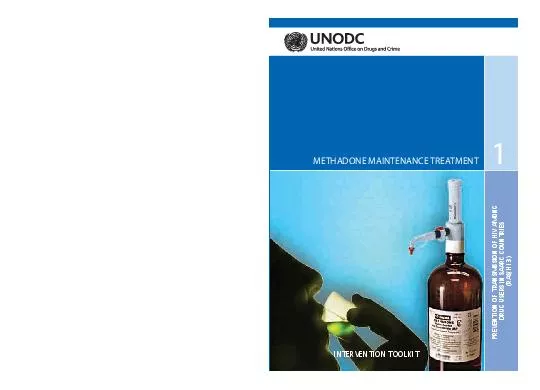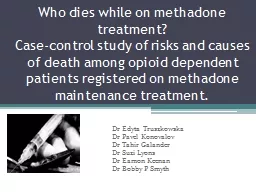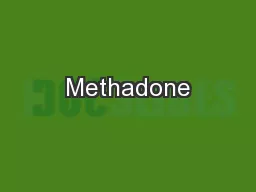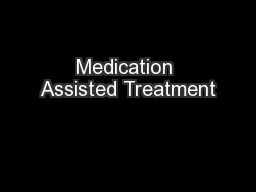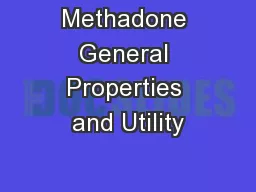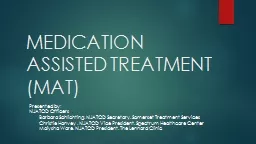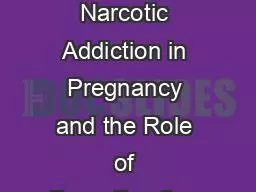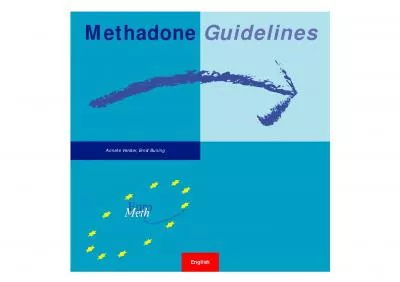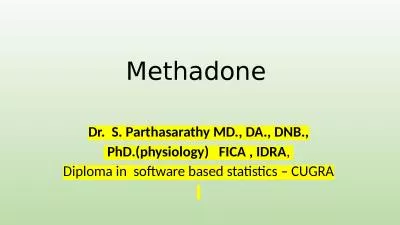PDF-METHADONE MAINTENANCE TREATMENT
Author : mitsue-stanley | Published Date : 2017-02-20
PREVENTION OF TRANSMISSION OF HIV AMONG DRUG USERS IN SAARC COUNTRIESRASH13 1 INTERVENTION TOOLKIT Q Can MMT patients use benzodiazepines A Benzodiazepine injection
Presentation Embed Code
Download Presentation
Download Presentation The PPT/PDF document "METHADONE MAINTENANCE TREATMENT" is the property of its rightful owner. Permission is granted to download and print the materials on this website for personal, non-commercial use only, and to display it on your personal computer provided you do not modify the materials and that you retain all copyright notices contained in the materials. By downloading content from our website, you accept the terms of this agreement.
METHADONE MAINTENANCE TREATMENT: Transcript
PREVENTION OF TRANSMISSION OF HIV AMONG DRUG USERS IN SAARC COUNTRIESRASH13 1 INTERVENTION TOOLKIT Q Can MMT patients use benzodiazepines A Benzodiazepine injection is associated with vascular d. WHAT WORKS?. SHELLEY ASKEW FLOYD, MS. DIRECTOR OF PHARMACOTHERAPY SERVICES. PYRAMID HEALTHCARE, INC.. 1. OBJECTIVES:. 1. . Understanding the importance of medication assistance treatment(MAT) in a . Case-control . study of risks and causes of death among opioid dependent patients . registered on . methadone maintenance treatment. .. Dr . Edyta. . Truszkowska. Dr . Pavel. . Konovalov. . Dr . Tahir. Bernard J. Lapointe. Associate Professor, department of Oncology and of Family Medicine. Eric M. Flanders Chair in Palliative Medicine. Potential conflict of interest. I have not received any support from the pharmaceutical industry in regard of the study or the clinical use of methadone.. for Opioid Use Disorders. Melissa Weimer, DO, MCR. Assistant Professor of Medicine, OHSU. Medical Director, CODA, Inc.. Learning Objectives. Understand the basis for medication assisted treatment and how it fits into one model of addiction treatment. Learning Objective. Identify the unique pharmacological properties of methadone that distinguish it from other opioids. Learn . key properties of methadone . lending itself to . treatment . of . cancer . Presented by:. NJATOD Officers. Barbara . Schlichting. , NJATOD Secretary, Somerset Treatment Services . Christie . Hanvey. , NJATOD Vice President, Spectrum Healthcare Center. . Maiysha. Ware, NJATOD President, The . Fighting the Stigma. Jeffrey Quamme . Executive Director, Connecticut Certification Board. 2018 UVU Conference. Orem, Utah. Our Goals For Today. Understand the history of MAT for Opioid Use Disorders. University of California. San Francisco. VA Medical Center. San Francisco. History of Opioids. The “Pod of Pleasure”. OTC Opiates. Opium. Smoker. Opium in San Francisco. Gentlemen prefer…opium. Jaye M Shyken, MD. St Louis University School of Medicine. Oct 3, 2018. I Have No Financial Conflict of Interest to Report. 2017 Opioid Addiction in the US. In 2016, 11.8 million Americans age 12 or older misused opioids (4.4%). website: http://www .q4q.nl/methwork TABLE OF CONTENTS IntroductionTarget group and Outline Paper 8Chapter 1 : State of the Art of Methadone in PhD.(physiology) FICA , IDRA. , . Diploma in software based statistics – CUGRA. . History – Myth and the fact ! . Adolph Hitler – injuries of world war 2 – analgesic morphine was in shortage . Dr. Sonalika’s Eye Clinic provide the best Paediatric ophthalmology treatment, Paediatric eye checkup treatment in Pune, Hadapsar, Amanora, Magarpatta, Mundhwa, Kharadi Rd, Viman Nagar, Wagholi, and Wadgaon Sheri Dr. Sonalika’s Eye Clinic provide the best Eye infection treatment, Conjunctivitis treatment in pune, Hadapsar, Amanora, Magarpatta, Mundhwa, Kharadi Rd, Viman Nagar, Wagholi, and Wadgaon Sheri Dr. Sonalika’s Eye Clinic provide the best Conjunctivitis (Pink Eye) treatment in Pune, Hadapsar, Amanora, Magarpatta, Mundhwa, Kharadi Rd, Viman Nagar, Wagholi, and Wadgaon Sheri
Download Rules Of Document
"METHADONE MAINTENANCE TREATMENT"The content belongs to its owner. You may download and print it for personal use, without modification, and keep all copyright notices. By downloading, you agree to these terms.
Related Documents

